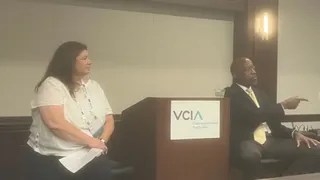
Long-term succession planning vital: VCIA panel
Succession planning needs to be fully thought out and not left to chance. That was the overwhelming sentiment of a panel of industry leaders, speaking at the Vermont Captive Insurance Association conference, taking place in Burlington, Vermont, this week.
The discussion, entitled “Long View Succession Planning” was guided by Joe Carter, strategic advisor and retired vice president of United Educators, and Katie Hawley, coach & consultant at Hawley Consulting Services. The session involved widespread input from the audience, who shared their own tales of succession planning done right – and done wrong.
Carter, reflecting on his two decades on the executive team of United Educators, underscored succession planning as a constant priority rather than an occasional exercise. He framed it as a blend of risk management and talent development — a forward-looking discipline that positions organisations to thrive beyond current leadership. Hawley reinforced the importance of intentionality, urging leaders to “lean equally” into both risk and talent considerations.
The room’s first collective response to succession planning was telling: words such as complicated, chaotic, essential, and nauseous revealed both its strategic weight and emotional charge. For many attendees, the stakes were personal. One participant recounted the sudden death of a CEO, describing how a prepared plan prevented operational chaos. Others pointed to the real-world impact of failing to address knowledge transfer, especially when critical expertise sits in the “legacy brain” of long-serving staff.
Practical advice flowed freely. Carter recommended reviewing succession plans every two years, supported by tangible documentation to aid communication and readiness. Hawley stressed the value of documenting future capability needs — often more than one successor may be required to match a single incumbent’s skill set. Attendees shared tools such as shared online hubs and standard operating procedure repositories, alongside habits of deliberately exposing potential successors to board members, key stakeholders and real-world decision-making.
However, the discussion also moved beyond systems to culture. Several contributors acknowledged the reluctance of some employees to share knowledge, fearing loss of influence, while others noted the undervaluing of veteran insight by newer colleagues. The panellists emphasised creating open, “institutional” relationships that outlast individuals, with Hawley calling for leaders to actively cultivate connections for their successors.
Generational shifts emerged as another challenge. Organisations face widening gaps between established leaders and younger employees who are less inclined to stay for decades. Carter urged investment in development and conference participation to build a robust bench, while Hawley encouraged tailored conversations around motivation and professional growth to improve retention.
Networking was repeatedly highlighted as a safeguard — not only within the organisation but across the industry — so that individuals can pivot if succession plans change or external hires are prioritised. Attendees candidly addressed competition, politics and the unpredictability of board decisions, accepting that flexibility must be built into any long-term plan.
The discussion group closed with a reminder that succession planning is not solely about replacing leaders. It is an ongoing, future-focused practice of strengthening talent pipelines, embedding organisational knowledge, and fostering relationships that keep the enterprise resilient. As Carter put it, the goal is to “skate where the puck is going,” ensuring continuity not just for today, but for the challenges yet to come.
Celebrate 40 Years of VCIA!
As the captive community gathers in Burlington for the VCIA Annual Conference, explore our special 40th Anniversary Edition. Packed with exclusive interviews, regulator insights, and reflections from industry leaders, it’s a tribute to four decades of innovation, connection, and leadership in Vermont’s captive market.
Read this Special Edition now.
Did you get value from this story? Sign up to our free daily newsletters and get stories like this sent straight to your inbox.

.jpg/r%5Bwidth%5D=320&r%5Bheight%5D=180/e9784380-eaf7-11f0-8cca-8f5587b01fb2-Daniel%20Towle_CICA_Shutterstock.webp)